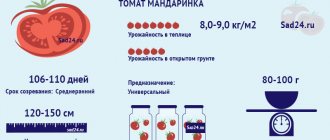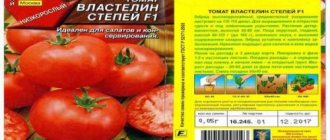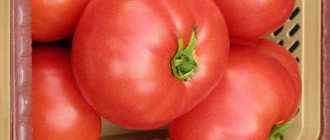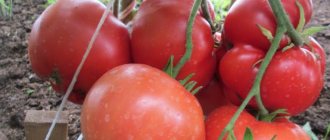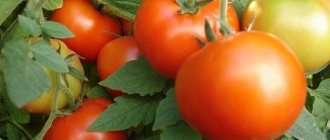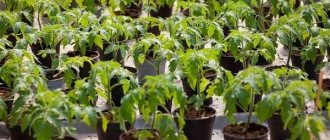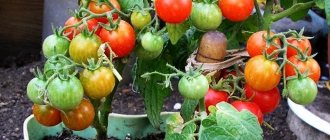Description of the variety
The Khlebosalny tomato is a variety of Siberian selection that was bred at the beginning of this century and has been in demand among Russian vegetable growers for about two decades.
This tomato was bred by breeders from Novosibirsk and after variety testing in 2006, it was included in the Russian State Register of Agricultural Achievements. The variety was bred specifically for cultivation in regions with a short summer period for cultivation primarily in greenhouse conditions. However, the Khlebosolny tomato also feels great in garden beds if it is planted in regions with warmer climatic conditions.
The Khlebosolny tomato is a medium-early variety in terms of fruit ripening - from the moment of germination of the seed material to the harvesting of ripe tomatoes, it usually takes about 4 months.
Features of bushes
Hospitable tomato bushes belong to the determinate type, so the growth of their shoots is usually limited to the formation of a flower cluster at the top. The height of these plants is usually 0.8 m, they branch well, and the shoots are well leafy.
Tomato bushes Khlebosolny are spreading and strong. However, the shoots should be supported or tied to strong supports, as they can bend or break under the weight of large ripening fruits.
The foliage of this tomato is large, quite long, wrinkled, with narrow tips, and a rich emerald color.
Features of the fruit
The flowers are small, yellow, collected in racemes. Up to 5 ovaries can form in each brush. The first brush is usually formed under 5-6 true leaves, and each next one is formed after a couple of leaflets.
This tomato variety is large-fruited - on average, the fruits weigh about 0.6 kg. But in the lower tier, tomatoes can ripen up to 1.0 kg.
Ripe fruits are even and smooth, oval in shape, slightly flattened at the stalk, with slight ribbing.
The skin of the fruit is dense, but is usually not noticeable in food. Its color is deep red. The pulp is fleshy and has a sweet, pleasant taste. It contains up to 5-6 seed chambers with a small number of seeds.
The skin of fruits at the ripening stage is light green, with a darker green color at the stalk. But at the moment of full ripening, the fruits are completely red, and even at the base there is no dark spot.
Important! If at the time of fruit ripening the soil or air humidity is too high, the tomatoes may crack.
Fruiting of the Khlebosolny tomato variety is extended over time, but if some of the tomatoes do not have time to ripen before the onset of cold weather, they are picked at the stage of milky ripeness and left to ripen indoors. In the warmth, tomatoes ripen quickly, but if the tomatoes are put in the refrigerator to ripen, they will ripen gradually over about 40-45 days.
The harvested crop can easily be transported to different distances and can be stored in a cool place for quite a long time.
Distinctive features
The distinctive features of the Hospitable tomato include:
- fairly large fruit size;
- round, slightly flattened and ribbed shape of tomatoes;
- low growth of bushes;
- the possibility of growing tomatoes in garden beds and in greenhouse conditions.
Also, Novosibirsk specialists developed another variety of this variety - the Hospitable pink tomato. Tomatoes of this variety are distinguished by the color of their skin - they are red with a pinkish tint. These fruits have a more pleasant taste, and their shelf life is longer than that of the harvested tomato Khlebosolny.
Characteristics of tomato
According to the description of the originator and after testing, the characteristics of the Khlebosolny tomato were revealed:
- high-yielding variety;
- tolerates dry or wet weather well;
- resistant to short-term frosts and temperature changes;
- do not wrinkle during transportation and retain their presentation;
- resistant to fungal diseases and not subject to frequent attacks by pests;
- the taste is sweet, slightly sour, aromatic.
Based on the results of the tasting, it received a rating of 4 out of 5, which is confirmed by many reviews from summer residents about the Khlebosolny tomato variety.
Characteristics of the variety
This tomato quickly adapts to any weather conditions, does not reduce growth and fruiting during sudden temperature fluctuations, and calmly tolerates periods of heat and drought, as well as the rainy season.
Advantages and disadvantages
The main advantages of the Khlebosolny tomato include:
- large fruit size;
- high productivity;
- the ability to collect seed material from your own ripe tomatoes;
- long fruiting;
- high resistance to stressful situations - the bushes calmly tolerate short-term frosts, extreme heat and periods of rain, without slowing down the growth and ripening of fruits;
- seedlings take root perfectly in a new place;
- The immunity of the Hospitable tomato is high, so its bushes are practically not affected by pathogenic microorganisms and are rarely attacked by harmful insects;
- can grow and bear fruit well in light partial shade.
Among the disadvantages of this variety it should be noted:
- fruits may crack in high humidity conditions;
- the yield of the variety directly depends on the fertility of the soil and the regularity of fertilizing;
- fruits can have different sizes;
- You cannot preserve ripe tomatoes whole because of their large size;
- Not all vegetable growers like the taste of the fruit;
- shoots require a mandatory garter, and supports must be installed under large fruits.
Application area
This tomato variety is classified as a salad tomato, so its fruits are primarily used for fresh consumption, summer salads and other types of snacks are prepared. But the yield of the Khlebosolny tomato is high, so housewives use part of the harvest to make preparations for the winter - lecho, tomato paste and juice, as well as delicious ketchups. You can also preserve these large tomatoes in pieces, because whole fruits simply won’t fit into jars.
Productivity and fruiting
The fruiting of the Khlebosolny tomato is extended over time. And if, when grown in the northern regions in greenhouse conditions, some of the fruits do not have time to fully ripen, then they are removed and left to ripen at home.
From each square of area, you can harvest up to 8-9 kg of ripe fruits, and from one bush, with good agricultural technology, vegetable growers can harvest up to a bucket of large tomatoes.
Growing regions
This tomato variety was specially bred for cultivation in the northern regions - western Siberia and the Urals under short, cool summer conditions. However, vegetable growers successfully grow the Khlebosalny tomato in the middle zone, the Moscow region and other Russian regions with similar climatic conditions. This tomato grows well even in the southern regions.
Features of cultivation
Khlebosolny is grown using the standard seedling method. At the time of planting, the age of the seedlings should be 55...60 days. By this time, they will have formed a strong root system, a thick trunk up to 30 cm high and 8...10 leaf blades.
The seedlings are planted on a pre-prepared planting site according to the standard pattern of 40x60 cm or 50x50 cm. Thus, 3...4 plants will be placed per 1 m2 of area. Hospitable shows the best yield values when formed into 2 or 3 stems. Some gardeners grow plants with 4 stems, but the fruits will grow smaller in size. Since the bushes are quite branchy, you should not thicken the standard planting scheme.
A distinctive feature of the Khlebosolny tomato variety is its rapid rooting in a new place. Usually, no problems arise after planting the bushes - they quickly adapt to new conditions and begin to grow.
During the season, standard care operations are carried out - regularly, but moderately, watering, weeding and loosening the soil under the bushes. To achieve high yields of Khlebosolny, fertilizing should not be neglected. They are especially important at the flowering and fruiting stages. At the same stages, it is recommended to hill up the bushes. This event is aimed at developing and strengthening the root system of plants.
Hospitable practically does not need stepsoning. You can step it up moderately or do without this operation altogether. Rationing of flower ovaries is not necessary, but is necessary for growing giant fruits. If a gardener has set this particular goal, he should leave no more than 5 flowers on different racemes on one bush. All other ovaries and flowers are blinded (cut off). Thus, there will be few fruits, but their weight will be enormous.
In general, Khlebosolny bushes are not tied up, but especially heavy clusters may need additional support or garter.
How to grow seedlings
'Valleycat' is the tomato variety Bexar County Master Gardeners will introduce to area gardeners during the 2014 rodeo.
It is being grown at Peterson Brothers Wholesale Nursery The Hospitable tomato is grown exclusively by seedlings, and seed material for sowing can be purchased in specialized stores, or can be collected from your own ripe fruits - their characteristics will be approximately the same.
Seed preparation
The seed material that was purchased at a seed store does not require pre-sowing preparation, since all the necessary procedures with the seeds were carried out by the manufacturer.
Seeds that were collected from your own tomatoes should first be prepared for planting:
- First, they are checked for germination by dipping them into a glass of salted water. All seeds that rise to the surface can be thrown away - they are empty inside and will not sprout. The rest that have sunk to the bottom must be removed. Usually, even the Khlebosalny tomato seeds collected by vegetable growers from their own fruits have a high germination rate - at least 80-85%;
- then the seeds are placed in a cotton bag, tied and placed in a container with a saturated solution of potassium permanganate to disinfect. Then the seeds need to be washed;
- In order for the seed material to sprout faster, it should be soaked in a solution of any of the growth stimulants. Usually, soaking in such a solution is also carried out for seed material purchased in a specialized store.
After all the procedures have been completed, the seeds are ready for planting.
Container and soil
It is also recommended to disinfect the containers in which Khlebosolny tomato seedlings will be grown before use, even if they are new.
Important! Previously used containers must be disinfected.
Before use, new containers are usually washed with warm water and laundry soap, then rinsed and dried.
Previously used plastic containers are washed with any antiseptic, then rinsed and dried. Wooden boxes should be soaked in an antiseptic solution for half an hour, then washed with running water and dried.
Need to know! A solution of potassium permanganate or bleach is usually used as a disinfectant.
After this, all containers are ready for use.
To plant tomato seeds, most vegetable growers use a nutrient substrate for growing vegetable seedlings, purchased in specialized stores. The composition of such soil mixtures already includes all the necessary nutrients, as well as components for imparting looseness to the soil.
But some summer residents prefer to prepare such nutrient mixtures for planting Khlebosolny tomato seeds for seedlings on their own at home. To do this, they have been preparing the following components since the fall:
- turf land;
- high peat;
- humus or compost;
- river sand;
- sawdust;
- wood ash.
At home, such soil is prepared several days before planting the seeds. To do this, mix turf, peat and humus in equal parts, then add 500 g of river sand and sawdust to the resulting soil mixture for every 10 kg of nutrient substrate.
Nutrient soil prepared at home should be disinfected. To do this, it can be calcined in the oven, steamed in a water bath, or spilled with a weak solution of potassium permanganate. And only after that can it be laid out in prepared containers.
Sowing
In the soil laid out in containers, grooves should be made 1 cm deep at a distance of 2.5-3 cm from each other. Water the soil, then place tomato seeds in it. They need to be covered with a thin layer of soil on top, watered again and covered with transparent film or glass on top of the container to create the effect of a greenhouse inside. All containers are placed in a warm place until the seeds germinate.
Important! If everything is done correctly, the first shoots will appear within 5-6 days after sowing the seed.
Growing and care
After friendly shoots appear in the containers, the polyethylene is removed and the container is transferred to a bright place. When caring for growing tomato seedlings, it is very important to observe the watering regime, as well as provide the sprouts with sufficient lighting.
Seedlings are watered regularly - it is important that the top layer of soil is moist all the time, and that excess moisture quickly drains through the drainage holes in the containers. Water for irrigation should be warm and filtered.
When seedlings do not have enough lighting, they begin to reach for the light, as a result their stems will be thin and weak. After transplantation, such seedlings will take a long time to acclimatize in a new place, will grow more slowly, fruiting of such plants will occur later than expected, and the yield will be lower.
Therefore, it is so important to provide tomato seedlings with sufficient daylight. When growing tomato seedlings, it should be 12-13 hours. If natural light is not enough, then phytolamps should be installed next to the seedlings to provide additional illumination to the plants.
When the seedlings have a pair of permanent leaves, they are picked out in separate cups. And a couple of weeks after this procedure, the plants are fed with fertilizers containing large amounts of nitrogen. Two such feedings are carried out with an interval of 12-14 days.
Need to know! Nitrogen-containing fertilizers accelerate the growth of green mass of seedlings and their roots, which is why it is so important to apply them at the seedling growth stage.
A couple of weeks before transplanting the seedlings to a permanent place, they should be hardened off by taking them out into the fresh air for a short time. But gradually the time outside for these plants is increased, and in recent days young tomatoes are left outside both day and night.
Growing rules
Hospitable tomato is intended for growing in open ground and under film cover, in seedlings. It needs to be sown in special containers with loose soil 55-60 days before transplanting into open ground. On a plot of 1 sq. m. 3-5 bushes should be planted in place, with slight partial shade during the day. The peculiarity of the Hospitable Tomato is that it does not tolerate picking, so it is sown immediately in separate containers.
Planting seedlings
Tomato soil needs to be rich in organic fertilizers with a high content of nitrogen and potassium. To prepare it, mix turf soil, peat, sand, ash, rotted manure, then fill the containers 2/3 full (plastic, peat or box), water the soil with warm water. Before sowing, seeds are soaked in a pale solution of manganese for 30-40 minutes, pulled out to drain and sown in containers, covering with 1-1.5 cm of earthen mixture. Cover with glass or stretch plastic wrap on top, place in a warm place with diffused light . After 4-7 days, after germination, they are placed on the windowsill and the seedlings are gradually accustomed to the open air, first removing the polyethylene for a few minutes. The container must be constantly rotated once a week so that the seedlings grow evenly.
The time for sowing seeds depends on the growing region, in general it should be 50-60 days before planting in open ground. If the Khlebosolny tomato seedlings are planned to be transplanted at the end of May, then they are sown at the end of February, the first ten days of March. If at the beginning of June, then sow in March. Early planting of tomato seedlings does not always have a favorable effect on further growth and fruiting.
Tomato transplant
Tomato seedlings are transplanted from the end of April to the first ten days of June, depending on the region, the warmer the earlier. For 1 sq. m. 3-5 plants are planted at a distance of 50-80 cm from each other and between rows of 60-80 cm, the planting pattern must be followed so that there is ventilation between the bushes, otherwise diseases may arise and the ripening of fruits will worsen. It should be replanted when the soil has warmed up to at least 16-20°C in the evening.
Transplant stages:
- Dig up the soil in advance along with organic fertilizers, add sand, ash, manure, then spill the area with a disinfectant against diseases and pests; you can use boiling water for this purpose.
- Dig holes 15-20 cm deep, 15-18 cm in diameter, add fertilizer and water with warm water.
- When the water is absorbed, install the support and place one bush in the hole, sprinkle with soil mixture and press the soil a little. When the seedlings adapt and begin to rise, add soil mixture and make a hole around the bush. As the seedlings grow, they are tied to the support with an elastic band.
Important! Before planting in holes, pinch off the edge of the main root, which will promote better growth of stems and the growth of lateral roots.
How to grow tomatoes
Further cultivation of this variety of tomatoes involves preparing beds or greenhouses for planting seedlings, transplanting the grown seedlings to a permanent place, and observing agrotechnical measures for caring for the growing bushes.
Landing
The place for transplanting tomato seedlings Khlebosolny is usually prepared in the fall. All remnants of vegetation are removed from the garden, organic matter is added (up to 8 kg for each square of area) and the soil is dug up using a shovel and organic fertilizers are incorporated into the soil. And in the spring, before planting the seedlings, beds are prepared in which planting holes are made.
Important! On each square of area, no more than 4 holes are usually prepared, both when growing in garden beds and when planting in a greenhouse.
In the fall, all structures in the greenhouse are disinfected and the top layer of soil in the beds is replaced with a new one. If it was not possible to replace the soil, then it is also disinfected, like the structures.
Seedlings of this tomato can be transplanted into greenhouses in the last ten days of April or in the first ten days of May, and into garden beds - no earlier than the last ten days of May.
A handful of superphosphate and potassium salt should be placed at the bottom of the holes, and a small layer of soil on top, on which a tomato seedling with a lump of earth is placed. The holes are filled with soil from above, watering is carried out, and the root zone is mulched from above with a layer of peat.
Features of cultivation and possible difficulties
The main thing when growing this variety of tomato is that the plantings are not thickened. In this case, the bushes will interfere with each other during growth, they will not have enough nutrition, so their development will slow down, and the yield will be lower than expected.
When growing Khlebosolny tomato in greenhouse conditions, it is important to monitor the level of soil and air moisture. If it is increased due to frequent and abundant watering, then fungal diseases will develop in the greenhouse.
This large-fruited variety requires frequent feeding, otherwise the fruits will not grow large.
Transfer
Before planting on the site, tender seedlings need to be hardened off. This will make it easier for her to take root in a new place and quickly grow. For 10 days, she is taken out into the fresh air and kept there for 2-3 hours. A day before transplantation, she is left overnight under cover on the street.
The optimal time for planting in the greenhouse is the first half of May, in the garden - the last ten days of May.
Site and soil
The hospitable tomato likes to grow in the sun, on moderately moist soil and in a windless place. The soil should be light, well-drained and low acidity.
The bed is prepared in the fall. Choose a place where cucumbers, cabbage, onions, garlic or legumes previously grew. Remove all weeds and remaining vegetation. Per 1 m², add 10 kg of leaf compost or rotted manure, 3-4 kg of wood ash, 100 g of superphosphate and 80 g of potassium salt. To deoxidize the soil, you need to add 300 g of slaked lime or chalk.
Large doses of ash (up to 3-4 kg per square meter) can only be applied on acidic soils. On neutral and slightly alkaline systems, the annual ash application rate should be no more than 250-300 g per square meter. Ash alkalizes the soil.
After this, deep digging is carried out. 2 weeks before the planned planting, the garden bed is watered with one of the following disinfectants:
- concentrated solution of potassium permanganate;
- urea solution - 1 tbsp. l. substances into a bucket of water.
Disembarkation scheme
Seedlings are planted according to a 50x50 cm pattern. The optimal number per 1 m² is 5-6 plants. Holes dug according to the size of the root system of the seedlings are watered with water - 0.5 liters each. A support about 1 m high is installed next to each hole. The roots are lowered into the holes, sprinkled with soil and hilled up.
In the first 3-4 days, it is necessary to create a shelter for tomatoes from the scorching sun from burlap or agrofibre. At night, plantings are covered with film to protect them from freezing.
White agrofibre serves both as protection from the scorching sun during the day and from low temperatures at night or during cold snaps.
Care
Further care for Khlebosolny tomato bushes consists of observing the watering regime, applying fertilizing, forming bushes, gartering and pinching.
Watering
Bushes of this variety should be watered once every 4-6 days, soaking the soil to a depth of 0.4 m when watering. And carrying out surface watering only weakens these vegetable plants.
To ensure that moisture evaporates more slowly from the soil, it is recommended to regularly mulch the tomato beds with lawn grass or straw.
During the period of active growth of the green mass of the bushes, it is recommended to keep the soil in the beds moist, and during the period of fruit ripening, it is useful to dry the soil a little so that the tomatoes ripen faster.
Top dressing
This variety of tomato needs more fertilizing than regular varieties of tomatoes. Therefore, in addition to the standard application of fertilizers after transplanting seedlings, during flowering and active fruiting, a couple more fertilizing is applied to the Khlebosolny tomato - at the stage of ovary formation and additionally during fruit ripening.
To feed this tomato, organics and mineral complexes are used, which alternate with each other. You can also use a solution of cow manure and bird droppings, as well as an infusion of green grass. During the flowering period, it is recommended to spray the bushes of this tomato with a solution of boric acid (5 g of this product is dissolved in 5 liters of water).
Bush formation
Tomato bushes Khlebosolny usually form 2-3 shoots. To do this, one or two stepsons are left under the first brush that appears, from which the side stems will grow. The remaining stepsons should be removed as they appear.
Since the fruits of this tomato are too large, the shoots should be tied to strong stakes or trellises, and additional supports should be placed under the lower clusters on which the heaviest tomatoes grow.
Temperature and humidity
Since this tomato variety was bred specifically for cultivation in regions with a short cool summer period, its bushes calmly grow and bear fruit at temperature fluctuations from +15 to +40ᵒС.
This tomato can easily tolerate short periods of drought and excessive watering. However, if there is a rainy season or the tomato bushes are constantly over-moistened, it is necessary to simultaneously carry out preventive treatments of the plants against fungal diseases.
Subsequent care for tomatoes
The Hospitable tomato is an unpretentious variety to care for, but to increase the volume of fruiting, the stepsons are cut off from the leaf axils to the first formed clusters. Stepchildren are cut off, leaving 0.3-0.5 cm of leaves in the axils, in the evening or morning, so that the cut sites heal faster. It is optimal to trim them when they have not grown more than 3-4 cm.
Watering is carried out once a week as the soil dries, or daily in a small amount in dry weather until the fruits form, after which the amount of watering is reduced. Water with warm, settled water and ammonium nitrate until clusters form once every 10 days, which will promote rapid growth of stems. Dilute 1 matchbox of saltpeter per 10 liters of water, stirring until completely dissolved. Water around the bush so that splashes of water do not fall on the stems, leaves and flowers.
When the first cluster with flowers begins to form, the soil is mulched with hay, pulled out weeds, sawdust, and organic fertilizers.
After each watering, rain, or when the soil cracks, it is necessary to ram the soil, which will allow more oxygen to penetrate into the soil. Weeds are removed as the area becomes overgrown.
Hilling up the bushes is done 2-3 times per season, especially when water begins to erode the roots of the tomato, and also as the seedlings grow and the lower leaves are torn off.
The bushes are tied up when the first flowers or fruits form
Common mistakes when growing
Sometimes, when growing this variety of tomato, vegetable growers make mistakes, due to which the plants may grow worse and their yield will decrease:
- tomato bushes are watered little at the stage of formation of the vegetative mass;
- Insufficient amounts of fertilizer are applied to the bushes;
- the formation of bushes and the removal of stepsons is not carried out;
- the bushes are not tied up, as a result they break under the weight of the fruit;
- do not monitor the level of humidity; if it rises too much, the fruits may crack.
Positive features of the variety
The main advantages of the Khlebosolny tomato variety include:
- good yield;
- resistance to changes in weather conditions;
- the bushes of this tomato do not require special care;
- resistance to major tomato diseases;
- the harvested crop can be transported to any distance;
- Ripe fruits of the Khlebosolny variety can be stored in appropriate conditions for a long time.
No particular shortcomings have been identified in the Khlebosolny tomato; it should only be noted that the bushes and brushes of this variety require obligatory tying to supports and subcortex, otherwise they will break under the weight of the fruit.
The nuances of growing in open ground and in a greenhouse
When growing in open ground, be sure to dig a strong stake next to the plant when planting tomato seedlings in open ground, to which the shoots will be tied during the growth process.
During the growth of the bushes, you need to hill up the root zone of the plants at least 3 times. As a result of such procedures, plants develop many lateral roots, which will be a source of additional nutrients, which will lead to an increase in yield.
As the fruits ripen, the foliage above them is torn off; the norm for removing leaves is no more than 3 in 2-3 days.
In greenhouse conditions, you should monitor the humidity level and regularly ventilate, especially after watering.
Reviews from gardeners who planted
Since Khlebosolny is a variety widely known among summer residents, on the Internet you can easily find many comments and reviews from those who have already encountered its cultivation in practice. Having analyzed the reviews, it can be noted that almost all gardeners throughout Russia managed to obtain a high yield of tomatoes with good fruit characteristics. But there are also rare cases when people fail to grow this variety for several seasons in a row.
Medinilla:
“I really love this variety. Previously, there was no greenhouse; I grew it under film. Now they are planted in the greenhouse annually. Hospitable never let you down. One of the first to ripen. To prevent the tomatoes from being clumsy, I pluck out the double flowers. Otherwise there would be even more tomatoes. The tomatoes are large, fleshy, not at all sour, with a rich tomato taste.”
Gggalina:
„The most favorite variety. It is declared as average, but in reality it belongs to the early ones. Very tasty and productive. The flesh is fleshy, but not dry. If the tomatoes in the brush are smaller, their size is larger. Ripe fruits are not stored for a long time - no more than two weeks.”
Mrs. Tomato:
“I planted it in open ground. The variety meets all the declared characteristics, I liked the taste and yield.”
Natalia:
“I grow bread-salting plants only in open ground. Once I tried to plant it in a greenhouse, the result was worse. I don’t tie up the bushes; I put boxes under the bunches as a support.”
Lars01:
“I’m cool about large tomatoes, but the name itself intrigued me, so I bought a bag of seeds. I asked my friends about the variety, they said that it was very popular at one time. The growing result is excellent. I picked the first tomato from the bush, tasted it and burst into bliss. I think it will be great for juices and ketchups. Productivity is high.”
Controller07:
“We plant different varieties of tomatoes – for canning, for salads, and just to eat a large tomato with salt. Khlebosolny has been delighting our entire family for several years now with its large fruits. The fruits are very tasty, sweet, fleshy. The bushes grow up to 80 cm.”
Diseases and pests
The tomato of this variety is highly resistant to many diseases characteristic of other varieties of vegetable crops from the nightshade family, in particular, it is practically not affected by fusarium, late blight, tobacco mosaic and many others.
But in greenhouses, the Khlebosolny tomato can be affected by gray, white, top and root rot.
Also, harmful insects such as spider mites, whiteflies and aphids can settle on the bushes of this tomato.
Pest and disease control
In the process of fighting different types of rot, you need to treat the bushes with a weak solution of potassium permanganate, as well as phytosporin.
To get rid of aphids, the vegetative mass of the bushes is washed with a soap solution. Insecticidal preparations such as Taran, Medilis-Tsiper or Sipaz-super are most effective against spider mites.
It must be remembered that from the moment the ovaries form on tomato bushes, it is impossible to use chemicals to combat pests or diseases.
Preventative treatment
To prevent various types of rot from developing in greenhouse conditions, the following preventive measures should be taken:
- regular ventilation of the greenhouse;
- remove lower leaves and weeds;
- Apply a layer of straw or lawn grass mulch to the root zone.
Pest and disease control
According to the breeders, the hospitable tomato has average immunity to pests, so preventive spraying should be carried out twice a season, but no less than 20-25 days before the first fruits ripen.
Parasites that may appear on the Khlebosolny tomato variety:
- aphid;
- Colorado beetle;
- spider mite;
- whitefly
Insecticidal agents are used against them: Aktara, an aqueous mixture of soap with ground black pepper, Fitoverm, Aktellik, Confidor.
The Khlebosolny tomato variety has strong immunity from most diseases, but for prevention it needs to be treated with fungicides: Ridomil, Quadris, Trichodermin, Bordeaux mixture.
Harvesting and application
The tomatoes of this tomato are harvested as they ripen to give other fruits that have set an opportunity to ripen.
The variety is a salad variety, so the fruits are used mainly fresh - in salads and snacks. Many vegetable growers remove some of the fruits at the stage of milky ripeness and put them in the refrigerator, where the crop ripens gradually over 1-1.5 months, without losing its good appearance and pleasant taste. This is how housewives preserve fresh tomatoes longer in order to be able to eat fresh tomatoes for a long time.
Productivity
The fruiting of the Khlebosolny tomato is extended over time, the fruits appear on the bushes gradually - the first clusters are formed in the lower part of the bushes, then - as the shoots grow - ovaries are formed on the upper part of the plants.
The Khlebosolny variety has an average yield - up to 9 kg of ripe produce can be collected from one square
. But those farmers who grew this variety on their plots say that with proper care, the yield increases, so you can harvest up to 5 kg of ripe tomatoes from each bush.
Reviews
Varvara, 50 years old, Moscow region: a couple of years ago I was buying tomato seeds in a store for planting in the garden and accidentally bought a bag of Khlebosolny tomato. I grew all my tomatoes, including this one, in a greenhouse. Surprisingly, with almost the same care for all varieties, huge tomatoes grew on the Khlebosolny tomato bushes - from each bush I collected 12 fruits, each of which weighed at least 450 g. I made summer salads from the harvested crop, as well as twists for the winter. My family especially liked the small tomatoes in Khlebosolny tomato juice.
Maria, 45 years old, Bryansk region: I planted this tomato in my greenhouse for the first time last year. I grew this tomato in seedlings and then cared for it according to all the rules. As a result, the yield was high - up to 7-8 kg from each square of area. And new tomatoes were formed on the bushes at the end of August. As a result, they had to be removed from the bushes at the stage of milk maturity, since under natural conditions they would not have ripened. They put them in a dark room to ripen, and made salads and snacks from the ripening fruits.
Fruit characteristics
Let's start looking at the description and reviews of the Khlebosolny tomato with the fruit. After all, many vegetable growers are primarily concerned with the quantity and quality of the harvest. The breeders have done their best in this regard. Firstly, the variety turned out to be large-fruited. On average, one tomato weighs about 600 g. Fruits weighing from 300 to 800 g can ripen on a bush. On the lower tier, with good feeding, giants weighing up to 1 kg grow. Secondly, the taste of the tomato is of great value. The fleshy pulp is quite sweet, juicy, but not watery. The skin is strong and thin. When eating the fruit, it is practically not felt.
Tomatoes grow round in shape with a flattened top and an area near the stalk. Faint ribbing is visible on the walls. The seed chambers of the fruit contain few grains. When a tomato has reached full maturity it becomes red with a pink tint.
Important! Despite the fact that the tomato variety is large-fruited, the harvested crop during the period of technical maturity can be preserved for a long time.
The Khlebosolny variety is considered a salad variety. The fruits are used for decoration, as well as for preparing dishes, especially dietary and children's dishes. Tomatoes can be processed. The fruit makes excellent juice, thick paste or ketchup. Tomatoes are not used for canning. The dense pulp and skin will withstand any heat treatment, but due to its dimensions, the fruit simply will not fit into the neck of the jar.
Photo
This variety of tomato has practically no disadvantages, and all its positive characteristics are confirmed by those vegetable growers who have been growing it for several seasons. Summer residents also claim that when growing Khlebosolny tomatoes on their plots, the size of the tomatoes and their taste are much greater than indicated in the description.
Advantages and disadvantages of the variety
Hospitable tomatoes are one of the most unpretentious and productive varieties. Its distinctive advantage is tasty, large tomatoes that can be grown even in the climatic conditions of Siberia and the Urals.
Hospitable tomatoes bear fruit until mid-September
pros
- excellent taste;
- stable harvest;
- immunity to various diseases;
- ability to withstand temperature changes;
- bushes tolerate even low light levels well;
- low maintenance requirements;
- Tomatoes also retain their quality well after transportation.
Minuses
- tomatoes are not suitable for whole-fruit canning;
- bushes need to be tied up, and regular pinching should be carried out.
History of selection
This tomato variety was bred by breeders from Siberia at the beginning of this century. After the tests, the Khlebosolny tomato was included in the Russian State Register in 2006.
Growing regions
This tomato variety was specially bred for cultivation in the northern regions - western Siberia and the Urals under short, cool summer conditions. However, vegetable growers successfully grow the Khlebosalny tomato in the middle zone, the Moscow region and other Russian regions with similar climatic conditions. This tomato grows well even in the southern regions.
Tomato Hospitable: reviews from those who planted
Olga, 44 years old, Moscow region: I have been growing this tomato variety for many years, especially for preparing salads and snacks. I also prepare delicious tomato juice from the harvested crop for the winter. I grow bushes of this variety in greenhouse conditions, form them into 2 stems, and as a result I collect large tomatoes weighing about 400 g. I recommend this variety for planting to all vegetable growers.
Galina, 35 years old, Penza: I really like the Khlebosolny tomato variety. Although the variety is considered mid-season, in my greenhouse the fruits of this variety ripen early. The fruits are large and very tasty, good in salads, appetizers and sauces. I also close various vegetable salads with pieces of this variety of tomato for the winter.
Maria, 44 years old, Voronezh: I’ve been growing Tomato Khlebosolny for the third season through seedlings. Then I transplant the seedlings into garden beds - into open ground. The bushes are formed of medium size and require a mandatory garter. And during the period of fruit ripening, I place supports under the brushes so that they do not break off under the weight of the tomatoes. I really like the rich taste of ripe tomatoes of the Khlebosolny variety. I definitely preserve tomato juice and paste from them for the winter.
Lilia, 50 years old, Samara: I tried to grow this variety both in greenhouses and in open ground. And I can say that in the garden beds the Khlebosolny tomato fruits have a richer taste, more sweetness, probably because the fruits receive more sunlight. I don’t do gartering of shoots, but I place a wooden container under the ripening fruits.
The Khlebosolny tomato is well known to Russian vegetable growers, as it was bred more than 15 years ago.
Its large fruit, fairly high yield, resistance to natural disasters and diseases - these main positive qualities of the tomato have become the main reasons for the popularity of the Khlebosolny tomato.
Recently searched:
